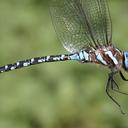United States and Canada
This large, western species is uncommon in southern New Mexico and western Texas, south to the lower Rio Grande Valley. It has blue eyes and a distinctly blue face. The black T on top of the frons is pronounced with an exceptionally broad stem. The first blue lateral thoracic stripe widens downward while the second widens upward. The wings are clear, occasionally becoming tinged with brown and the pterostigma is abbreviated, usually surmounting no more than two crossveins. The abdomen is dark brown with pale blue spots and a distinct ventral tubercle on segment 1. Abdominal segment 10 is usually darker than the preceding segments and has a distinct middorsal tubercle, bordered laterally by a pair of large yellow spots. Females may have either blue markings (rare ) or most often green-yellow thoracic stripes and muted yellowish-gray abdominal spots.
Size: Total length: 70-75 mm; abdomen: 49-55 mm; hindwing: 48-53 mm.
Similar Species (south-central US): Arroyo Darner is very similar to the much more common Blue-eyed Darner (A. multicolor), but the former is generally more robust. Males lack the strongly forked cerci present in Blue-eyed Darner. The thoracic stripes are generally wider and the anterior lateral thoracic stripe has a posterior extension at its upper end. It is easily distinguished from Variable Darner (A. interrupta) which as a black stripe on the fronto-clypeal groove and no tubercle on venter of abdominal segment 1. Females are similar to Paddle-tailed Darner (A. palmata), but that species lacks a ventral tubercle on segment 1. Blue-eyed Darner females are essentially identical can not be reliably separated.
Habitat: Pools of slow flowing permanent mountain streams, rivulets, and arroyos. Often found higher up the watershed towards the headwaters than Blue-eyed Dar
Natural History: This is a relatively uncommon species of the southwestern United States, but it can be a frequent visitor to arroyos and springs in open areas. It prefers pools edged with grass and trees rather than cattails (Typha).
Distribution: Southwestern U.S. from Texas to Arizona southward through Mexico to Oaxaca.
Source: Abbott, J.C. 2006-2010. OdonataCentral: An online resource for the distribution and identification of Odonata. Available at OdonataCentral.
Edited by Drew Weber (9/24/2015).
